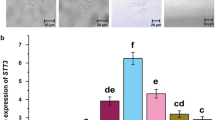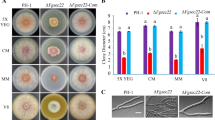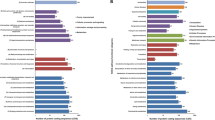Abstract
Trichoderma harzianum, a biocontrol agent for various plant pathogens, is known to degrade fungal cell walls; this mycoparasitism is believed to require secretion of cell-wall-degrading enzymes against host pathogens. In this study, we identified a homologue of yeast SNF1 (sucrose nonfermenting 1) encoding protein kinase in T. harzianum (ThSNF1) by draft genome sequencing of strain T36. Targeted gene disruption of ThSNF1 was performed using the PEG method with fusion PCR products. Growth of mutant ΔThSNF1 was markedly less than for the wild-type strain on minimal medium with chitin as a carbon source. The mutant exhibited reduced expression of the genes encoding chitinase and polygalacturonase and markedly reduced spore production. Mycoparasitism against plant pathogens such as Fusarium oxysporum f. sp. cubense (Panama disease) and Fusarium graminearum (Fusarium head blight) was clearly impaired in the mutant. The results suggest that ThSNF1 is critical for asexual development, utilization of certain carbon sources and virulence on fungi, and is therefore important for the biocontrol ability of T. harzianum.




Similar content being viewed by others
References
Abdullah F, Ilias GNM, Nelson M (2007) Hyperparasitic mechanisms employed by the fungal biocontrol agent in a Trichoderma–Ganoderma interaction. In: Exploring life as a catalyst for technological advancement. Proceedings of the 9th symposium of the Malaysian Society of Applied Biology, Universiti Sains Malaysia. Malaysian Society of Applied Biology, Kuala Lumpur, pp 107–130
Akamatsu H, Itoh Y, Kodama M, Otani H, Kohmoto K (1997) AAL-toxin-deficient mutants of Alternaria alternata tomato pathotype by restriction enzyme-mediated integration. Phytopathology 87:967–972
Benítez T, Rincón AM, Limón MC, Codón AC (2004) Biocontrol mechanisms of Trichoderma strains. Int Microbiol 7:249–260
Celenza JL, Carlson M (1984) Cloning and genetic mapping of SNF1, a gene required for expression of glucose-repressible genes in Saccharomyces cerevisiae. Mol Cell Biol 4:49–53
Chet I (1987) Trichoderma: application, mode of action and potential as a biocontrol agent of soilborne plant pathogenic fungi. In: Chet I (ed) Innovative approaches to plant disease control. Wiley, New York, pp 137–160
Cziferszky A, Seiboth B, Kubicek CP (2003) The Snf1 kinase of the filamentous fungus Hypocrea jecorina phosphorylates regulation-relevant serine residues in the yeast carbon catabolite repressor Mig1 but not in the filamentous fungal counterpart Cre1. Fungal Genet Biol 40:166–175
Dickman MB, Yarden O (1999) Serine/threonine protein kinase and phosphatases in filamentous fungi. Fungal Genet Biol 26:99–117
Ezziyyani M, Pérez SC, Ahmed AS, Requema ME, Candela ME (2004) Trichoderma harzianum como biofungicida para el biocontrol de Phytophthora capsici en plantas de pimiento (Capsicum annuum L) (in Spanish). Anal Biol 26:35–45
Hjeljord L, Tronsmo A (1998) Trichoderma and Gliocladium in biological control: an overview. In: Harman GE, Kubicek CP (eds) Trichoderma and Gliocladium, vol 2., Enzymes, biological control and commercial applicationsCRC Press, London, pp 129–151
Hoyos-Carvajal L, Duque G, Orduz PS (2008) Antagonismo in vitro de Trichoderma spp. sobre aislamientos de Sclerotinia spp. y Rhizoctonia spp. (in Spanish). Rev Colomb Cienc Hortic 2:76–86
Kuwayama H, Obara S, Morio T, Katoh M, Urushihara H, Tanaka Y (2002) PCR-mediated generation of a gene disruption construct without the use of DNA ligase and plasmid vectors. Nucleic Acids Res 30:e2. doi:10.1093/nar/30.2.e2
Lee SH, Lee J, Lee S, Park EH, Kim KW, Kim MD, Yun SH, Lee YW (2009) GzSNF1 is required for normal sexual and asexual development in the ascomycete Gibberella zeae. Eukaryot Cell 8:116–127
López-Mondéjar R, Catalano V, Kubicek CP, Seidl V (2009) The β-N-acetylglucosaminidases NAG1 and NAG2 are essential for growth of Trichoderma atroviride on chitin. FEBS J 276:5137–5148
Lorito M, Woo SL, Fernandez IG, Colucci G, Harman GE, Pintor-Toro JA, Filippone E, Muccifora S, Lawrence CB, Zoina A, Tuzun S, Scala F (1998) Genes from mycoparasitic fungi as a source for improving plant resistance to fungal pathogens. Proc Natl Acad Sci USA 95:7860–7865
Nayak T, Szewczyk E, Oakley CE, Osmani A, Ukil L, Murray SL, Hynes MJ, Osmani SA, Oakley BR (2006) A versatile and efficient gene-targeting system for Aspergillus nidulans. Genetics 172:1557–1566
Ninomiya Y, Suzuki K, Ishii C, Inoue H (2004) Highly efficient gene replacements in Neurospora strains deficient for nonhomologous end-joining. Proc Natl Acad Sci USA 101:12248–12253
Ospina-Giraldo MD, Mullins E, Kang S (2003) Loss of function of the Fusarium oxysporum SNF1 gene reduces virulence on cabbage and Arabidopsis. Curr Genet 44:49–57
Ronne H (1995) Glucose repression in fungi. Trends Genet 11:12–17
Ruijter GJG, Visser J (1997) Carbon repression in Aspergilli. FEMS Microbiol Lett 151:103–114
Seidl V, Huemer B, Seiboth B, Kubicek CP (2005) A complete survey of Trichoderma chitinases reveals three distinct subgroups of family 18 chitinases. FEBS J 272:5923–5939
Tonukari NJ, Scoot-Craig JS, Walton JD (2000) The Cochliobolus carbonum SNF1 gene is required for cell wall-degrading enzyme expression and virulence on maize. Plant Cell 12:237–247
Treitel MA, Kuchin S, Carlson M (1998) Snf1 protein kinase regulates phosphorylation of the Mig1 repressor in Saccharomyces cerevisiae. Mol Cell Biol 18:6273–6280
Vieira PM, Coelho ASG, Steindorff AS, de Siqueira LSJ, Silva RN, Ulhoa CJ (2013) Identification of differentially expressed genes from Trichoderma harzianum during growth on cell wall of Fusarium solani as a tool for biotechnological application. BMC Genom 14:177
Viterbo A, Haran S, Friesem D, Ramot O, Chet I (2001) Antifungal activity of a novel endochitinase gene (chit36) from Trichoderma harzianum Rifai TM. FEMS Microbiol Lett 200:169–174
Walton JD (1994) Deconstructing the cell wall. Plant Physiol 104:1113–1118
Woo SL, Lorito M (2007) Exploiting the interactions between fungal antagonists, pathogens and the plant for biocontrol. In: Vurro M, Gressel J (eds) Novel biotechnologies for biocontrol agent enhancement and management. Springer, Netherlands, Amsterdam, pp 107–130
Acknowledgments
We thank H. Suga for providing the fungal strains and R. P. Oliver for providing the transformation vector. This work was supported by the Global COE Program “Advanced Utilization of Fungus/Mushroom Resources for Sustainable Society in Harmony with Nature,” MEXT, Japan. We thank the National Secretary of Higher Education, Science, Technology and Education of Ecuador and the Biotechnology Research Center of Ecuador, Higher Polytechnic College of the Littoral CIBE-ESPOL for supporting this research.
Author information
Authors and Affiliations
Corresponding author
Electronic supplementary material
Below is the link to the electronic supplementary material.
Rights and permissions
About this article
Cite this article
Galarza, L., Akagi, Y., Takao, K. et al. Involvement of ThSNF1 in the development and virulence of biocontrol agent Trichoderma harzianum . J Gen Plant Pathol 81, 211–217 (2015). https://doi.org/10.1007/s10327-015-0590-2
Received:
Accepted:
Published:
Issue Date:
DOI: https://doi.org/10.1007/s10327-015-0590-2




